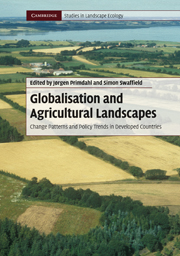Book contents
- Frontmatter
- Contents
- List of Contributors
- Preface
- 1 Globalisation and the sustainability of agricultural landscapes
- 2 Agricultural liberalisation, multifunctionality and the WTO: competing agendas for the future of farmed landscapes
- 3 Globalisation of agricultural landscapes: a land systems approach
- 4 Agricultural landscape changes through globalisation and biodiversity effects
- 5 Swiss agricultural policy reform: landscape changes in consequence of national agricultural policy and international competition pressure
- 6 Local landscape consequences of macro-scale policy reform: the New Zealand experiment
- 7 Rural landscape differentiation in the face of changing demands and policies: a typology of rural areas in Portugal
- 8 Globalisation and the local agricultural landscape: current change patterns and public policy interventions
- 9 From totalitarian to democratic landscapes: the transition in Estonia
- 10 Rural landscape change as a product of US federal policy
- 11 New approaches for urban–rural areas in Dutch spatial planning
- 12 Restoring agricultural landscapes in shrinking cities: re-inventing traditional concepts in Japanese planning
- 13 Globalisation and local agricultural landscapes: patterns of change, policy dilemmas and research questions
- Index
- References
4 - Agricultural landscape changes through globalisation and biodiversity effects
Published online by Cambridge University Press: 05 June 2012
- Frontmatter
- Contents
- List of Contributors
- Preface
- 1 Globalisation and the sustainability of agricultural landscapes
- 2 Agricultural liberalisation, multifunctionality and the WTO: competing agendas for the future of farmed landscapes
- 3 Globalisation of agricultural landscapes: a land systems approach
- 4 Agricultural landscape changes through globalisation and biodiversity effects
- 5 Swiss agricultural policy reform: landscape changes in consequence of national agricultural policy and international competition pressure
- 6 Local landscape consequences of macro-scale policy reform: the New Zealand experiment
- 7 Rural landscape differentiation in the face of changing demands and policies: a typology of rural areas in Portugal
- 8 Globalisation and the local agricultural landscape: current change patterns and public policy interventions
- 9 From totalitarian to democratic landscapes: the transition in Estonia
- 10 Rural landscape change as a product of US federal policy
- 11 New approaches for urban–rural areas in Dutch spatial planning
- 12 Restoring agricultural landscapes in shrinking cities: re-inventing traditional concepts in Japanese planning
- 13 Globalisation and local agricultural landscapes: patterns of change, policy dilemmas and research questions
- Index
- References
Summary
Introduction
Changes in agricultural systems through the process of globalisation and the need to increase farm productivity over the past few decades have led to dramatic land-cover changes as well as the introduction of new technologies that are major threats to biodiversity in many parts of the world (Donald et al., 2001; Norris, 2008). Loss of biodiversity is a global concern for many reasons. The first is that the loss of a species is a non-reversible process; this has led to Nature Conservation treaties and policies at world and national scales. The second reason is that species must be protected not only for their intrinsic value, but also because of the services they provide to society. The Millennium Ecosystem Assessment (www.millenniumassessment.org) has emphasised the latter aspect, and ‘ecosystem services’ (Carpenter et al., 2007; Zhang et al., 2007) is now a key word on many agendas, whether in the realm of nature protection or landscape management. From this perspective, the main cause of biodiversity loss is an overemphasis on production services (food and fibre) at the expense of other services such as water purification, pest control or pollination. The two main proximal causes that lead to loss of species are habitat loss (transformation of natural or semi-natural habitats to arable land) and heavy use of energy in the form of mineral fertilisers, especially nitrogen, pesticides and soil tillage (Matson et al., 1997). All have adverse effects, though they may favour some species that become pests.
- Type
- Chapter
- Information
- Globalisation and Agricultural LandscapesChange Patterns and Policy trends in Developed Countries, pp. 57 - 72Publisher: Cambridge University PressPrint publication year: 2010
References
- 3
- Cited by



